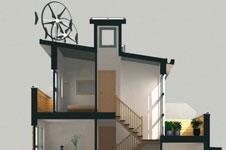Frustration at half-hearted eco-homes and a plea for high-rise housing – and one for opening the windows
Postscript
Video: Housebuilder casts doubt on renewable add-onsGreat to see warts and all feedback. Such a shame that so much time, money and false hope has been wasted on the current CSH approach given that the results that are emerging are no surprise to anyone with physics O level.
Nick Grant
It is good to see at least one housebuilder has realised that a high tech bandage will not solve the Eco-home issue. What is required is the redesign of the whole product to ensure the unit works efficiently to reduce the energy demand rather than replace the energy source and minimise maintenance requirements by the occupants. Will we see other housebuilders use the current downturn to develope and improve their products, I doubt it on past performance of product development and technological improvements.
Hugh Bantin
I think it is a shame when a builder relies so much on systems and technology, rather than utilizing sustainable materials and practices to create an energy efficient shell, orientation, and site prep to start with.
That is the key to getting power systems working correctly. The article did not state what kind of winds they got in the location they were in or what type of construction was used, but when you build with traditional building materials, you cannot expect to get the results you would get with an EE design.
Sustainable building is about site selection, building placement, and a solid, energy efficient shell made from sustainable materials. Once you have that, it is hard to go wrong.
Builders need to shift their thinking away from certain building and insulation materials, and learn more about what is out there today. We have lots of choices, and it is important to make those decisions with the most information.
Unfortunately this builder now has a bad taste in its mouth, so it will be interesting to see what it does next.
Terri Larsen
That past is goneThe tower blocks that were built in the 60's and 70's failed because they were for the most part poorly constructed and detailed. This was a direct response to government policy and financial incentives given to build high rise homes as quickly as possible to respond to a housing crisis.
Generally, they were poorly managed and maintained but nevertheless for all their faults they were more popular with tenants than medium rise walk up blocks with deck access. Space standards were high but allocation policies were flawed driven by the scarcity of available homes. The public realm surrounding the blocks was not well thought out and in many cases became a sea of concrete podia with no landscaping or sense of place.
If we are capable of learning the lessons from the past and commit ourselves to producing homes that are well designed and constructed then surely high rise housing can succeed.
It seems to me that the problem lies in collective amnesia in respect of the causes of past failure. Everything we do today in housing is heavily numbers driven without including quality and sustainability in the targets to be met. Without rigourous quality and high design standards we are in danger of wasting more public money and creating miserable housing for future generations.
Stephanie Al-Wahid
Eco-ventilation health scare prompts regulation changeOpen the windows, turn down the heating and take a hot water bottle to bed in the winter and you will be much healthier without harming the planet.
Gary Burt





























No comments yet